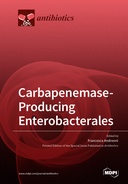Explore

Carbapenemase-Producing Enterobacterales
0 Ungluers have
Faved this Work
Login to Fave
Carbapenem-resistant Enterobacterales (CRE) are a common cause of infections in both community and healthcare settings and have become an increasing threat to public health worldwide. The focus of this Special Issue includes aspects concerning plasmid-mediated antimicrobial resistance along with other carbapenem resistance mechanisms. Understanding the prevalence and routes of transmission of CRE is important in developing specific interventions for healthcare facilities, as well as the general impact of CRE circulation on the environment. Attention has also been focused on carbapenemase testing in order to provide advanced phenotypic and molecular assays for the identification of CRE, as a valid tool for active global surveillance, and from this perspective, the study of resistance mechanisms can provide significant support for the development of new and appropriate antimicrobial molecules. For all of these reasons, the phenomenon of carbapenem resistance deserves more attention, for the sake of public health.
This book is included in DOAB.
Why read this book? Have your say.
You must be logged in to comment.
Rights Information
Are you the author or publisher of this work? If so, you can claim it as yours by registering as an Unglue.it rights holder.Downloads
This work has been downloaded 322 times via unglue.it ebook links.
- 322 - pdf (CC BY) at Unglue.it.
Keywords
- Animal
- antibiotic-resistance
- antimicrobial peptides
- antimicrobial resistance
- Biofilm formation
- Biology, Life Sciences
- blaOXA-48
- broth microdilution
- carbapenem
- carbapenem inactivation method
- carbapenem resistance
- carbapenem-resistance
- carbapenem-resistant Enterobacterales
- carbapenem-resistant Enterobacteriaceae (CRE)
- carbapenemase
- Carbapenemase producing Enterobacterales
- carbapenemase-producing Enterobacterales
- carbapenemases
- carbapenems resistance
- Cattle
- ceftazidime/avibactam
- ChromID colistin R agar
- Citrobacter farmeri
- colistin broth disc elution
- colistin susceptibility testing
- Colonization
- COVID-19
- CRE
- Eazyplex® SuperBug CRE assay
- efflux pump
- Enterobacterales
- Enterobacteriaceae
- Enterobacteriales
- Environment
- ERIC-PCR
- ESBL
- ESKAPE
- Etest
- extended-spectrum beta-lactamases
- extensively drug-resistant
- Food
- Fourier transform infrared spectroscopy
- Gram-Negative Bacteria
- gram-negative rods
- healthcare-associated infections
- Human
- IMP-6
- IncX-3
- Infection
- infection control
- K. pneumoniae
- Klebsiella michiganensis
- Klebsiella pneumoniae
- KPC
- KPC-2
- LAMP method
- long reads, plasmid
- Mathematics & science
- Microbiology (non-medical)
- micronaut MIC-strip colistin
- molecular epidemiology
- molecular typing
- multidrug resistance
- multilocus sequence typing
- multilocus sequence typing (MLST)
- NDM
- NDM-1
- neonates
- nosocomial
- nosocomial Infections
- One Health
- outbreak
- OXA-48
- PCR-based replicon typing
- PFGE
- plasmid
- plasmid profile analysis
- plasmid-typing
- Plasmids
- population analysis profiling
- porin
- porins
- pulsed-field gel electrophoresis (PFGE)
- Qatar
- rapid polymyxin NP test
- real-time multiplex PCR
- Reference, information & interdisciplinary subjects
- Research & information: general
- resistance genes
- sequence type
- sequence types
- Temporin L
- transposon
- VIM
- Virulence
- Vitek 2 compact
- wastewater
- Water
- whole genome sequencing
- whole-genome sequencing
Links
DOI: 10.3390/books978-3-0365-4029-0Editions

